steering wheel OLDSMOBILE SILHOUETTE 1993 Owners Manual
[x] Cancel search | Manufacturer: OLDSMOBILE, Model Year: 1993, Model line: SILHOUETTE, Model: OLDSMOBILE SILHOUETTE 1993Pages: 323, PDF Size: 17.13 MB
Page 47 of 323
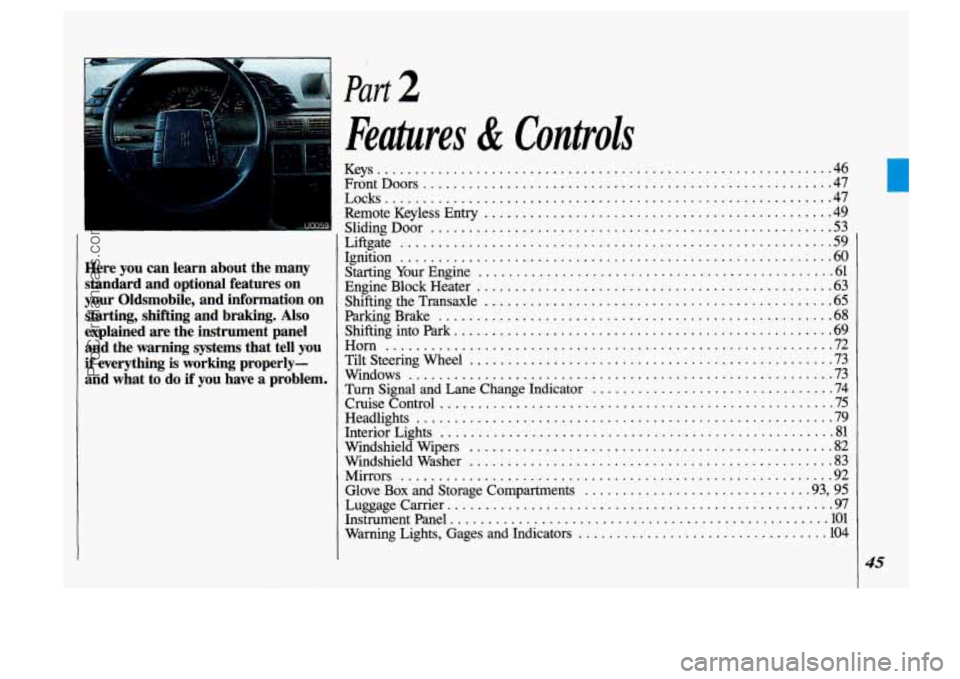
v..
.
Here you can learn about the many
standard and optional features on
your Oldsmobile. and information on starting. shifting and braking
. Also
explained are the instrument panel and the warning systems that tell you
if everything is working properly-
and what
to do if you have a problem .
Part 2
Features & Controls
Keys 46
FrontDoors
...................................................... 47
Remote Keyless Entry
.............................................. 49
Sliding Door 53
Liftgate
......................................................... 59
Ignition
......................................................... 60
Starting Your Engine
............................................... 61
Shifting the Transaxle
.............................................. 65
..........................................................
Locks ........................................................... 47
.....................................................
EngineBlockHeater ............................................... 63
ParkingBrake
.................................................... 68
Shiftingintopark
.................................................. 69
Horn ........................................................... 72
Windows
........................................................ 73
TiltSteeringWheel
................................................ 73
Turn Signal
and Lane Change Indicator ................................ 74
CruiseControl .................................................... 75
Headlights
....................................................... 79
Windshield Wipers
................................................ 82
Windshield Washer
................................................ 83
Mirrors
......................................................... 92
Glove
Box and Storage Compartments ............................. .93, 95
Luggagecarrier
....................................................
Instrument Panel .................................................. 101
Warning Lights, Gages and Indicators
................................. 104
InteriorLights
.................................................... 81
I'
45
L
ProCarManuals.com
Page 55 of 323
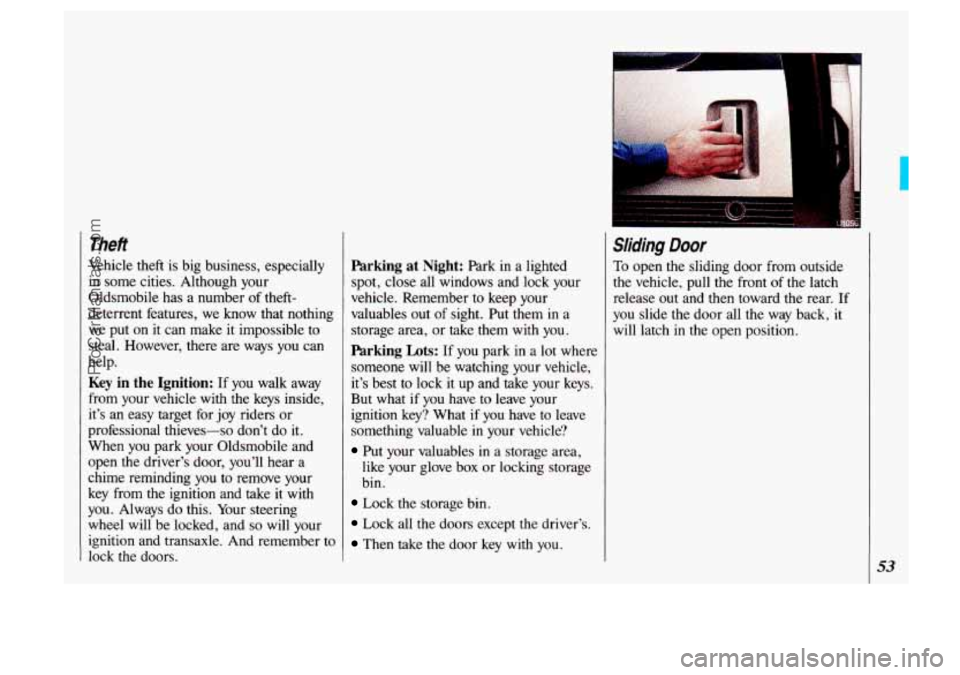
5
Theft
Vehicle theft is big business, especially
in some cities. Although your
Oldsmobile has a number of theft-
deterrent features, we know that nothing
we put on it can make it impossible
to
steal. However, there are ways you can
help.
Key in the Ignition: If you walk away
from your vehicle with the keys inside,
it's an easy target for joy riders or
professional thieves-so don't do it.
When you park your Oldsmobile and
open the driver's door, you'll hear a
chime reminding you
to remove your
key from the ignition and take it with
you. Always do this. Your steering
wheel will be locked, and
so will your
ignition and transaxle. And remember to
lock the doors.
Parking at Night: Park in a lighted
spot, close
all windows and lock your
vehicle. Remember to keep your
valuables out
of sight. Put them in a
storage area, or take them with you.
Parking Lots: If you park in a lot where
someone will be watching your vehicle,
it's best to lock it
up and take your keys.
But what if you have to leave your
ignition key? What if you have to leave
something valuable in your vehicle?
Put your valuables in a storage area,
like your glove
box or locking storage
bin.
Lock the storage bin.
Lock all the doors except the driver's.
Then take the door key with you.
Sliding Door
To open the sliding door from outside
the vehicle, pull the front
of the latch
release out and then toward the rear. If
you slide the door all the way back, it
will latch in the open position.
53
ProCarManuals.com
Page 62 of 323
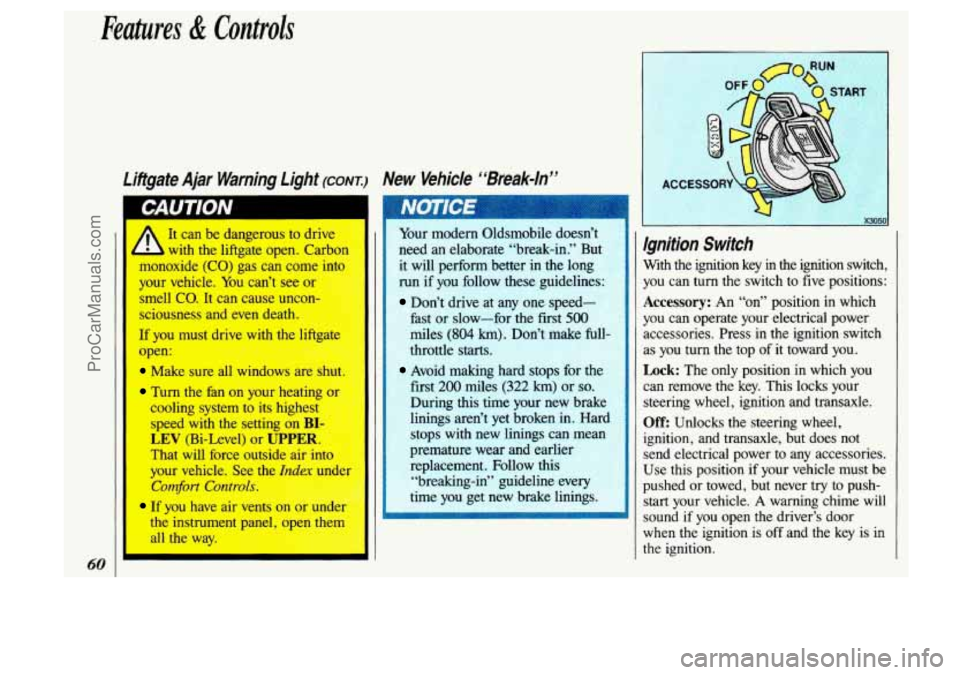
Features & Controls
60
Liitgate Ajar Warning light (CONT.) New Vehicle “Break-In”
It can be dangerous to dr’ A
b with the liftgate open. Cam
lllvnoxide
(CO) gas can come in1
your vehicle. You can’t see or
smell
CO. It can cause uncon-
sciousness and even death.
If you must drive with
tk lifti
open:
Make sure all window
Turn the fan on your heatinl
cooling system to its high--*
speed
with the setting on
LEV (Bi-Level) or UPPER
That will force outside air ir
your vehicle. See
the Index under I
Comfort Controls.
If you have air vents on or under
the instrument panel, open the1
all the way.
I
four modern Olasmobile doesnt
need
an elaborate “break-in.” But
it will
perform better in the long
run if you follow these guidelines:
Don’t drive at any one speed-
fast or slow-for the first 500
miles (804 km). Don’t make full- I
throttle starts.
Avoid making hard stops for the
first
200 miles (322 km) or so.
During this time your new brake
linings aren’t yet broken in. Hard
stops with new linings can mean
I
premature wear and earlier
I
lgnition Switch
With the ignition key in the ignition switch,
you can turn the switch to five positions:
Accessory: An “on” position in which
you can operate your electrical power
accessories. Press in the ignition switch
as you turn the top of it toward you.
Lock: The only position in which you
can remove the key. This locks your
steering wheel, ignition and transaxle.
Off: Unlocks the steering wheel,
ignition, and transaxle, but does not
send electrical power to any accessories.
Use this position if your vehicle must be
pushed or towed, but never try to push-
start your vehicle. A warning chime will
sound if
you open the driver’s door
when the ignition is off and the key is in
the ignition.
ProCarManuals.com
Page 63 of 323
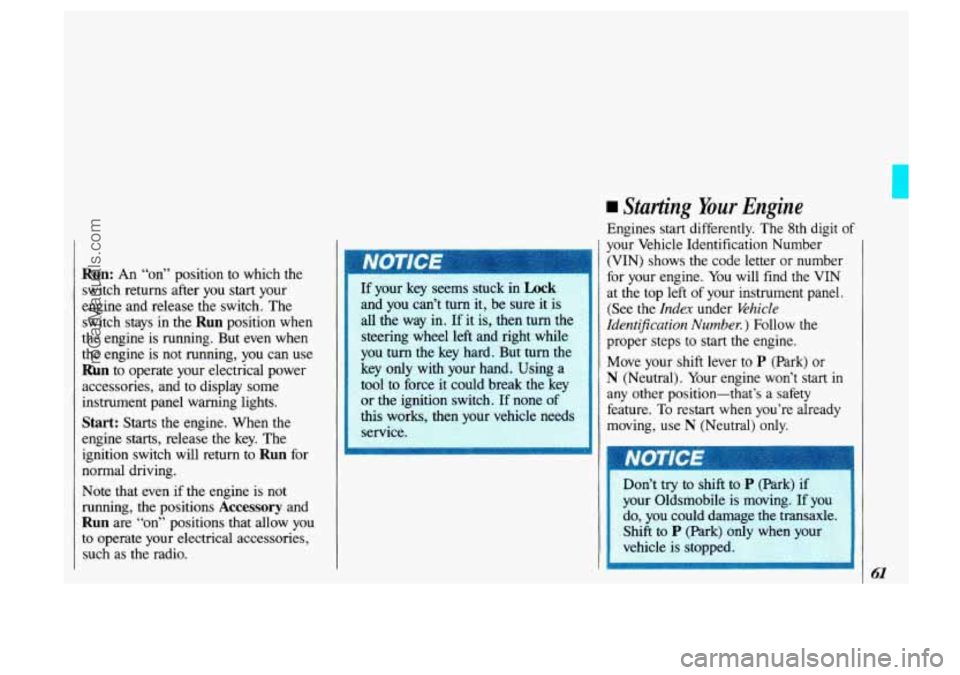
Run: An “on” position to which the
switch returns after you start your
engine and release the switch. The
switch stays in the
Run position when
the engine is running. But even when
the engine is not running, you can use
Run to operate your electrical power
accessories, and to display some
instrument panel warning lights.
Start: Starts the engine. When the
engine starts, release the key. The
ignition switch will return to
Run for
normal driving.
Note that even if the engine is not
running, the positions
Accessory and
Run are “on” positions that allow you
to operate your electrical accessories,
such as the radio.
I 1 and you can’t turn it, be sure it is
all the way
in. If it is, then turn the
steering wheel left and right while
you
turn the key hard. But turn the
: key only with your hand. Using a
-11 tool to force it could break the key
or the ignition switch. If none of
this works, then your vehicle needs
service.
Starting Your Engine
Engines start differently. The 8th digit of
your Vehicle Identification Number
(VIN) shows the code letter or number
for your engine. You will find the VIN
at the top left of your instrument panel.
(See the
Index under Vehicle
ZdentiJication
Number. ) Follow the
proper steps to start the engine.
I Move your shift lever to P (Park) or
N (Neutral). Your engine won’t start in
any other position-that’s a safety
feature.
To restart when you’re already
moving, use
N (Neutral) only.
I I
ProCarManuals.com
Page 74 of 323
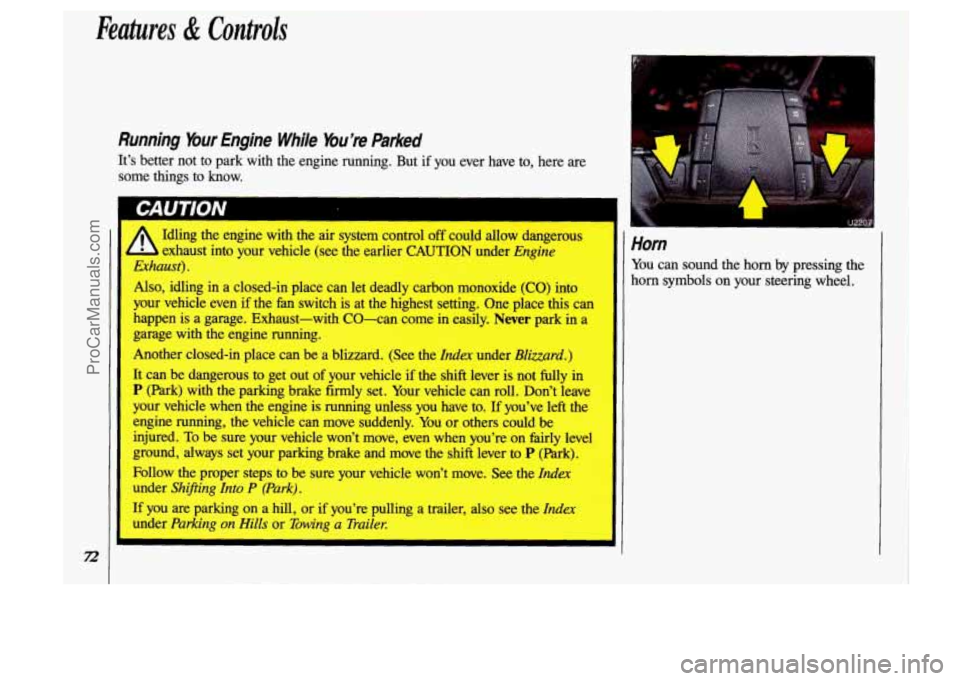
Features & Controls
n
Running bur Engine While You’re Parked
It’s better not to park with the engine running. But if you ever have to, here are
some things to know.
LAU I IUlV
A
Idling the engine with the air system control off could allow dangerous
exhaust into your vehicle (see the earlier CAUTION under
Engine
Exhaust).
Also, idling in a closed-in place can let deadly carbon monoxide (CO) into
your vehicle even if the fan switch
is at the highest setting. One place this can
happen is a garage. Exhaust-with CO-can come in easily.
Never park in a
garage with the engine running.
Another closed-in place can be a blizzard. (See the
Index under Blizzard.)
It can be dangerous to get out of your vehicle if the shift lever is not fully in
P (Park) with the parking brake firmly set. Your vehicle can roll. Don’t leave
your vehicle when the engine is running unless you have to.
If you’ve left the
engine running, the vehicle can move suddenly. You or others could be
injured.
To be sure your vehicle won’t move, even when you’re on fairly level
ground, always set your parking brake and move the shift lever to
P (Park).
Follow the proper steps to be sure your vehicle won’t move. See the
Index
under Shifing Into P (Park).
If you are parking on a hill, or if you’re pulling a trailer, also see the Index
under Parking on Hills or Towing a Trailer.
Horn
You can sound the horn by pressing the
horn symbols on your steering wheel.
ProCarManuals.com
Page 75 of 323
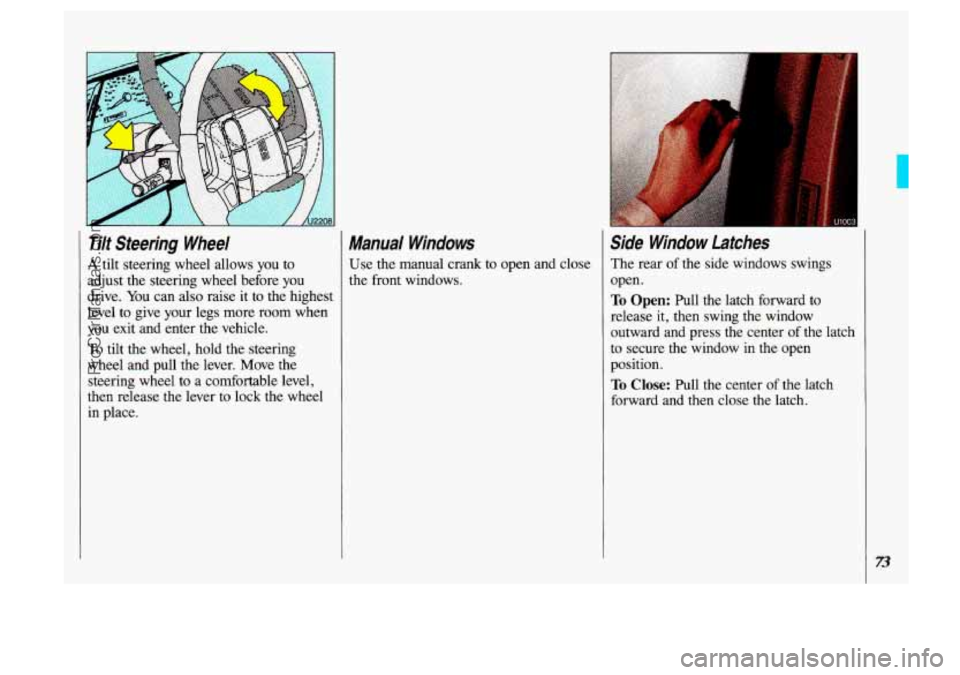
.-
Tilt Steering Wheel
A tilt steering wheel allows you to
adjust the steering wheel before you
drive. You can also raise it to the highest
level to give your legs more room when
you exit and enter the vehicle.
To tilt the wheel, hold the steering
wheel and pull
the lever. Move the
steering wheel to a comfortable level,
then release the lever to lock the wheel
in place.
Manual Windows
Use the manual crank to open and close
the front windows.
Side Window Latches
The rear of the side windows swings
open.
To Open: Pull the latch forward to
release it, then swing the window
outward and press the center
of the latch
to secure the window in the open
position.
To Close: Pull the center of the latch
forward and then close the latch.
ProCarManuals.com
Page 103 of 323

The Instrument Panel- Your Information System
Your instrument panel is designed to let
you know at a glance how your vehicle
is running. You’ll know how fast you’re
going, how much fuel you’re using, and
many other things you’ll need to drive
safely and economically.
Refer to the accompanying diagram of
your instrument panel
to locate the
components listed below.
1. Side Vents
2. Light Controls
3. Turn SignaVHeadlight Beam Lever
4. Tilt Steering Wheel Lever
5. Instrument Cluster
6. Gearshift Lever
7. WiperIWasher Controls
8. Center Vents
9. Storage Compartment
10. Side Vents
11. Circuit Breaker/Relay Panel
12. Glove Box/Fuse Panel
13. Audio System
14. Rear Fan Controls
15. Cup HolderdAshtray
1 6. Locking Storage Bin
17. Lighter
18. Interior Lights Override Switch
19. Climate Controls
20. Ignition Switch
21. Hazard Warning Flashers Switch
22. Horn
23. Parking Brake Release
24. Hood Release
101
ProCarManuals.com
Page 115 of 323
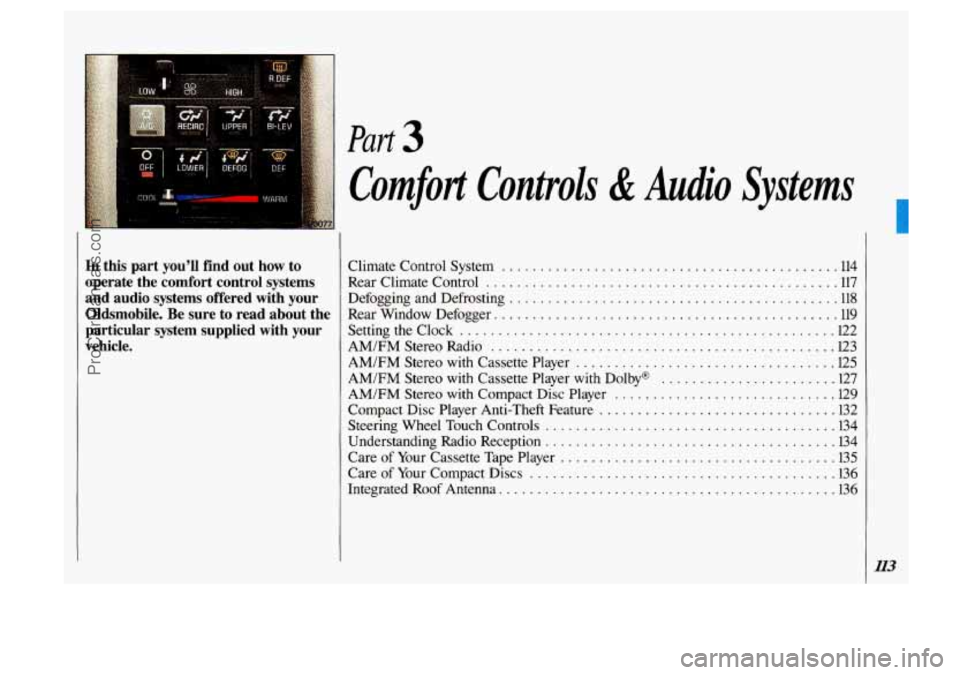
COOL ... Comfort Controls & Audio Svstems d
In this part you'll find out how to
operate the comfort control systems
and audio systems offered with your
Oldsmobile
. Be sure to read about the
particular system supplied with your
vehicle
.
Climate Control System ............................................ 114
Rear Climate Control
.............................................. 117
Rear Window Defogger
............................................. 119
Settingtheclock
................................................. 122
AM/FM Stereo Radio ............................................. 123
Defogging and Defrosting
........................................... 118
AM/FM Stereo with Cassette Player .................................. 125
AM/FM Stereo with Cassette Player with Dolby@ ....................... 127
AM/FM Stereo with Compact Disc Player
............................. 129
Compact Disc Player Anti-Theft Feature ............................... 132
Steering Wheel Touch Controls
...................................... 134
Understanding Radio Reception
...................................... 134
Care of Your Cassette Tape Player
.................................... 135
Care of Your Compact
Discs ........................................ 136
Integrated Roof Antenna
............................................ 136
113
ProCarManuals.com
Page 156 of 323
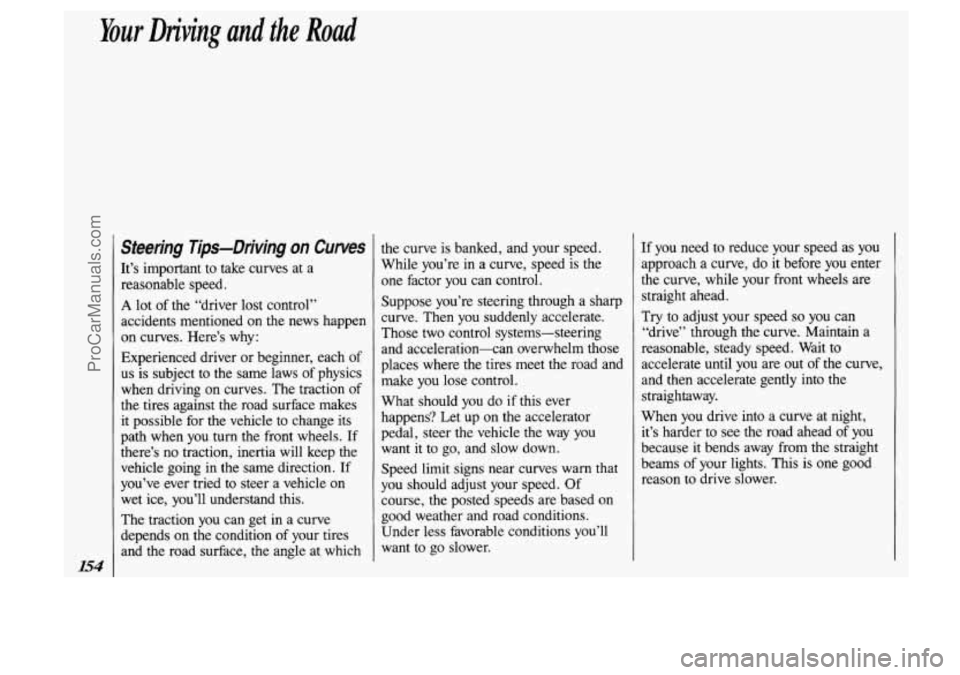
Your Driving and the Road
Steering Tips-Driving on Curves
It’s important to take curves at a
reasonable speed.
A lot of the “driver lost control’’
accidents mentioned on the news happen
on curves. Here’s why:
Experienced driver or beginner, each of
us is subject to the same laws of physics
when driving
on curves. The traction of
the tires against the road surface makes
it possible for the vehicle to change its
path when you turn the front wheels.
If
there’s no traction, inertia will keep the
vehicle going in the same direction.
If
you’ve ever tried to steer a vehicle on
wet ice, you’ll understand this.
The traction you can get in a curve
depends
on the condition of your tires
and the road surface, the angle at which the curve
is banked, and your
speed.
While you’re in a curve, speed is the
one factor you can control.
Suppose you’re steering through a sharp
curve. Then
you suddenly accelerate.
Those two control systems-steering
and acceleration-can overwhelm those
places where
the tires meet the road and
make you lose control.
What should you do if this ever
happens? Let up on the accelerator
pedal, steer the vehicle the way you
want it to go, and slow down.
Speed limit signs near curves warn that
you should adjust your speed. Of
course, the posted speeds are based on
good weather and road conditions.
Under less favorable conditions you’ll
want to go slower. If you need to
reduce your speed as you
approach a curve, do it before you enter
the curve, while your front wheels are
straight ahead.
Try to adjust your speed
so you can
“drive” through
the curve. Maintain a
reasonable, steady speed. Wait to
accelerate until you are out of the curve,
and then accelerate gently into the
straightaway.
When you drive into a curve at night,
it’s harder to see the road ahead
of you
because it bends away from the straight
beams of your lights. This is one good
reason
to drive slower.
ProCarManuals.com
Page 157 of 323
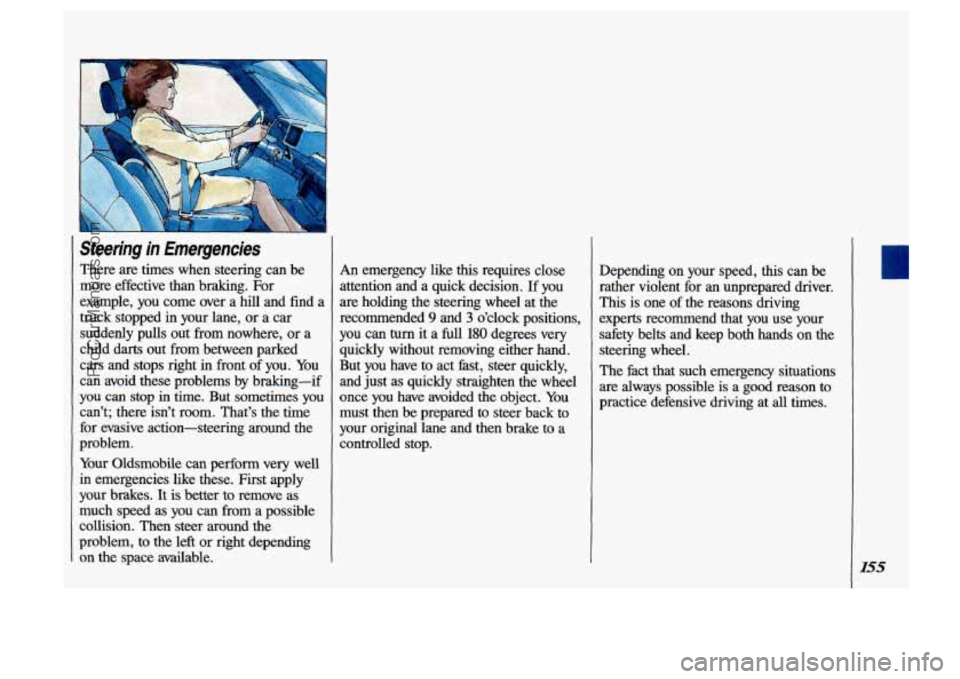
1 Steering in Emergencies
There are times when steering can be
more effective than braking. For
example, you come over a
hill and find a
truck stopped in your lane, or a car
suddenly pulls out from nowhere, or a
child
darts out from between parked
cars and stops right in front of you. You
can avoid these problems by braking-if
you can stop
in time. But sometimes you
can’t; there isn’t room. That’s the time
for evasive action-steering around the
problem.
, Your Oldsmobile can perform very well
in emergencies like these. First apply
your brakes.
It is better to remove as
much speed
as you can from a possible
collision. Then steer around
the
problem, to the left or right depending
on the space available.
An emergency like this requires close
attention and a quick decision.
If you
are holding the steering wheel at the
recommended
9 and 3 o’clock positions,
you can turn it a
full 180 degrees very
quickly without removing either hand.
But you have to act fast, steer quickly,
and just as quickly straighten the wheel
once
you have avoided the object. You
must then be prepared to steer back to
your
original lane and then brake to a
controlled stop. Depending on your
speed,
this can be
rather violent for an unprepared driver.
This is one of the reasons driving
experts recommend that you use your
safety belts and keep
both hands on the
steering wheel.
The fact that such emergency situations
are always possible is a
good reason to
practice defensive driving at all times.
ProCarManuals.com